Salesforce.com
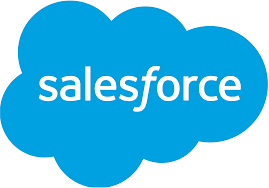
Scoop is able to grab any report data from Salesforce. To do this, use the Salesforce application option in Application Report option when creating a new dataset.
AI-Assisted Setup
When connecting Salesforce to Scoop, you can choose "Guide me with AI" for an intelligent, guided setup experience. Scoop offers pre-configured analysis templates that automatically select the right object and fields for common use cases.
Available Analysis Templates
| Template | Salesforce Object | Data Mode | Best For |
|---|---|---|---|
| Sales pipeline & opportunities | Opportunity | Snapshot | Pipeline tracking, win rates, revenue forecasting |
| Lead funnel & conversion | Lead | Snapshot | Lead progression, conversion rates, source effectiveness |
| Account & customer analysis | Account | Sync | Customer segmentation, industry analysis |
| Contacts & relationships | Contact | Sync | Contact database, role analysis |
| Support cases & service | Case | Sync | Case volume, resolution times, SLAs |
| Sales activities & tasks | Task | Sync | Rep productivity, activity patterns |
| Meetings & calendar events | Event | Sync | Customer engagement, meeting frequency |
| Marketing campaigns | Campaign | Sync | Campaign ROI, lead generation |
Understanding Snapshot vs Sync Mode
Scoop offers two data loading modes depending on your analysis needs:
Snapshot Mode (Opportunities, Leads):
- Captures daily snapshots of every record
- Enables tracking how records change over time
- Perfect for pipeline analysis, stage progression, forecast accuracy
- Required for questions like "How long do deals spend in each stage?"
Sync Mode (Accounts, Contacts, Cases, Tasks, Events, Campaigns):
- Keeps records up-to-date with the latest state
- Ideal for entity-based reporting and analysis
- Perfect for questions like "How many open cases do we have?"
Example Questions You Can Answer
Sales Pipeline (Opportunities):
- "What's our current pipeline value by stage?"
- "How has our win rate trended over the past year?"
- "What's the average sales cycle length by deal type?"
- "Which reps are hitting quota and which are falling behind?"
- "How accurate are our close date forecasts?"
- "What percentage of deals in Commit stage actually close?"
Lead Funnel (Leads):
- "What's our lead-to-opportunity conversion rate?"
- "How long does it take to convert leads from different sources?"
- "Which lead sources produce the highest-quality leads?"
- "What's our lead velocity—are we generating more leads month over month?"
- "How do conversion rates differ by industry or company size?"
Account Analysis:
- "What industries do our customers come from?"
- "What's the distribution of accounts by annual revenue?"
- "How is our customer base distributed geographically?"
- "What types of accounts (Customer, Prospect, Partner) do we have?"
Support Cases:
- "What's our average case resolution time?"
- "How does case volume trend over time?"
- "Which case origins (Email, Phone, Web) drive the most volume?"
- "What priority levels are most common?"
- "Which support agents handle the most cases?"
Sales Activities (Tasks & Events):
- "How many activities are sales reps logging per week?"
- "What's the distribution of activity types (calls, emails, meetings)?"
- "Which reps are most active? Which are falling behind?"
- "How does activity level correlate with deal outcomes?"
- "What's the average number of meetings before a deal closes?"
Marketing Campaigns:
- "Which campaigns generated the most leads?"
- "What's the ROI on our marketing spend by campaign type?"
- "How do lead conversion rates differ by campaign?"
- "What's the cost per lead by campaign?"
Pipeline Snapshotting for Sales Operations
The Sales pipeline & opportunities and Lead funnel templates use Scoop's snapshotting feature. This captures daily snapshots of your pipeline, enabling analysis that Salesforce alone cannot provide:
- Stage-to-stage conversion: What percentage of Proposal deals become Closed Won?
- Cycle time analysis: How long do deals spend in each stage?
- Pipeline velocity: Is your pipeline moving faster or slower than last quarter?
- Forecast accuracy: How do predicted close dates compare to actual closes?
- Deal movement tracking: Which deals moved forward, backward, or stalled this week?
- Historical trends: How has your win rate changed over the past year?
Tip: Enable snapshotting on day one. Sales ops teams typically need 30-90 days of snapshots for meaningful cycle time analysis, matching your typical sales cycle length.
Typical Salesforce.com Use Cases with Salesforce Only
Typical use cases for Scoop with Salesforce data only include:
- General Salesforce reporting with better visuals and analysis
- Snapshotting any/all attributes on any Salesforce object like Opportunities or Leads
- Analyzing sales and/or marketing processes to understand conversion rates and cycle times
- Combining Salesforce marketing lead data with Salesforce sales data to understand the full lifecycle and process for a customer from raw lead to closed deal.
- Conversion rates
- Cycle times
- Channel efficiency
Salesforce Instant Recipes
Scoop has several instant recipes created for Salesforce to get you started quickly. The recipes are pipeline waterfall, sales operations, sales team performance, and deal distribution.
- Pipeline waterfall: Gain powerful insights into every shift in your sales pipeline with advanced waterfall analysis. Track what’s been added, removed, won, lost, or resized across your entire pipeline, broken down by individual deal owner and deal type. Dive deeper into specific deals to take immediate action and drive results
- Sales operations: Gain powerful insights into every shift in your sales pipeline with advanced waterfall analysis. Track what’s been added, removed, won, lost, or resized across your entire pipeline, broken down by individual deal owner and deal type. Dive deeper into specific deals to take immediate action and drive results
- Sales team performance: Access real-time sales metrics like pipeline performance, deal velocity, and forecasting directly from Salesforce. This recipe consolidates key data to offer immediate insights, helping you track trends and optimize your sales operations
- Deal distribution: Understand which types of deals are being done and who is doing them. With deal distribution analysis you can see at a glance where your business is coming from
Salesforce Snapshotting
One of the biggest uses of Scoop for Salesforce is snapshotting. Scoop can snapshot your deals automatically. This allows for critical analysis of fundamental sales processes by understanding how things change in a sales process and why. Scoop allows Salesforce users to snapshot their deals and detect, track and report on all changes, how fast those changes occur and at what rates - allowing deep insights into the sales process.
Typical Use Cases Combining Salesforce.com with other Applications
Combining Salesforce data with other types of data opens up very powerful analysis options that can really help a marketer optimize their performance. While Salesforce allows some limited ability to bring in some outside sources, like basic financial data, the integration is much more complex and the data and analysis options are limited. Scoop opens up tremendously rich opportunities to slice and dice Salesforce data in conjunction with data from other applications.
Uncaptured Audience or Channel Data
Because Scoop can easily handle spreadsheets, lookup tables that augment attributes for your campaign are very easy to add. It's exceptionally easy and painless to augment your marketing data with key attributes that likely are either anecdotal or captured in some sort of ad hoc way. Scoop makes it extraordinarily simple to include this data by maintaining it in a spreadsheet and being able to join that spreadsheet to your other marketing data.
Financial Expense Data
Financial applications such as NetSuite, QuickBooks or other accounting applications can bring in expense data very easily into Scoop. This enables some powerful analysis:
- Dollar cost efficiency of marketing efforts: This analysis allows you to assess by campaign, audience, channel, message, etc. the efficiency of dollars in to dollars out of closed won deals. This use case combines snapshot lead data, snapshot sales data and financial expense data for marketing campaigns.
- Customer acquisition cost
- Cost per lead analysis
Service Data
To understand better what audiences might be more expensive to serve, Scoop allows you to blend your marketing or sales data with data from your service desk (e.g. Zendesk)
Product Usage Data
Understand the usage patterns of your customers based on their marketing segmentation.
Engineering Data
Understand what types of customers cost the most in terms of engineering time by integrating with a tool like Jira.
Connecting to Salesforce
To connect to Salesforce as a datasource, create a new dataset linked to Salesforce. First, on the datasets page, select applications as a source:
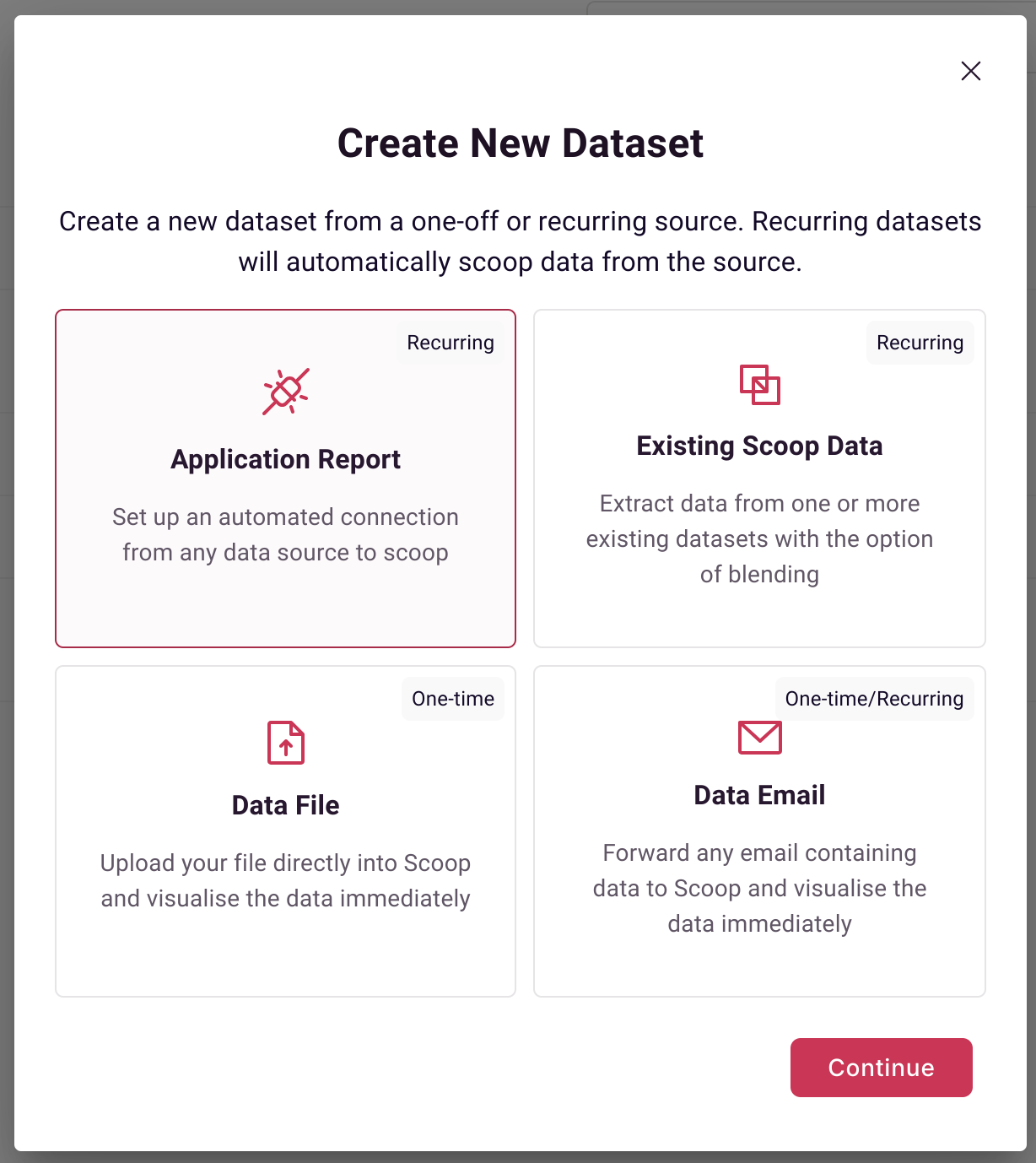
Next, select Salesforce:
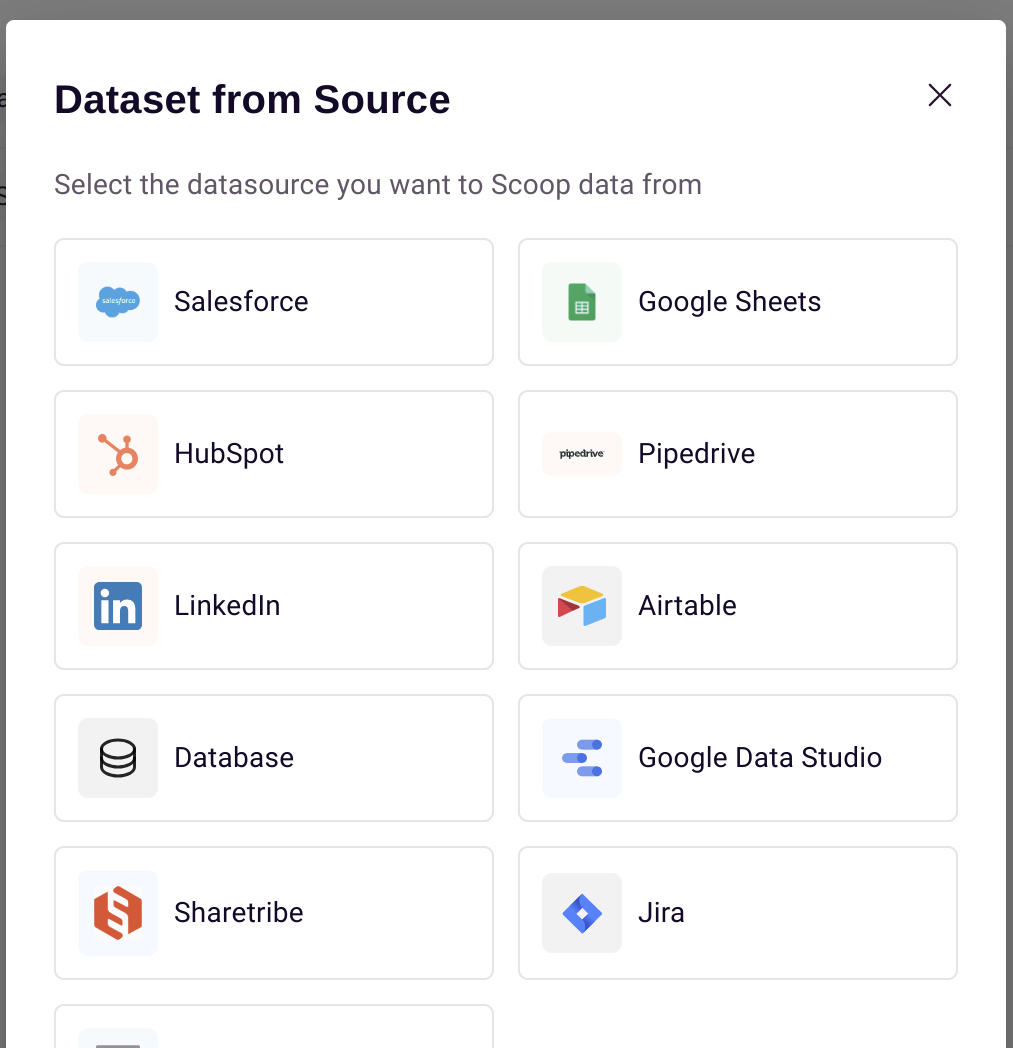
Loading from a Report vs. API
With Salesforce you can select either a report data source or using the API as a data source. The advantage of using a report as a data source is that any linked fields from different objects will be properly displayed in your report and can therefore be easily loaded. With the API, often items that link to different objects do so via an ID field. This requires you to bring in both objects and then use Scoops blending capabilities to lookup the required field from the linked object. For example, on a Salesforce opportunity you have the Owner ID, but to see the owner name you need to bring in the owner object and use Scoop to blend those sources together. If you use a report, you can have those fields already filled out with no additional data work required. And, since Salesforce supports automated emails, setup is as simple as auto-forwarding (using your own auto-forward, or Scoop's Gmail/Exchange integrations) that email to Scoop. Setup can be done in minutes.
Loading from the API
Select API Data Source:
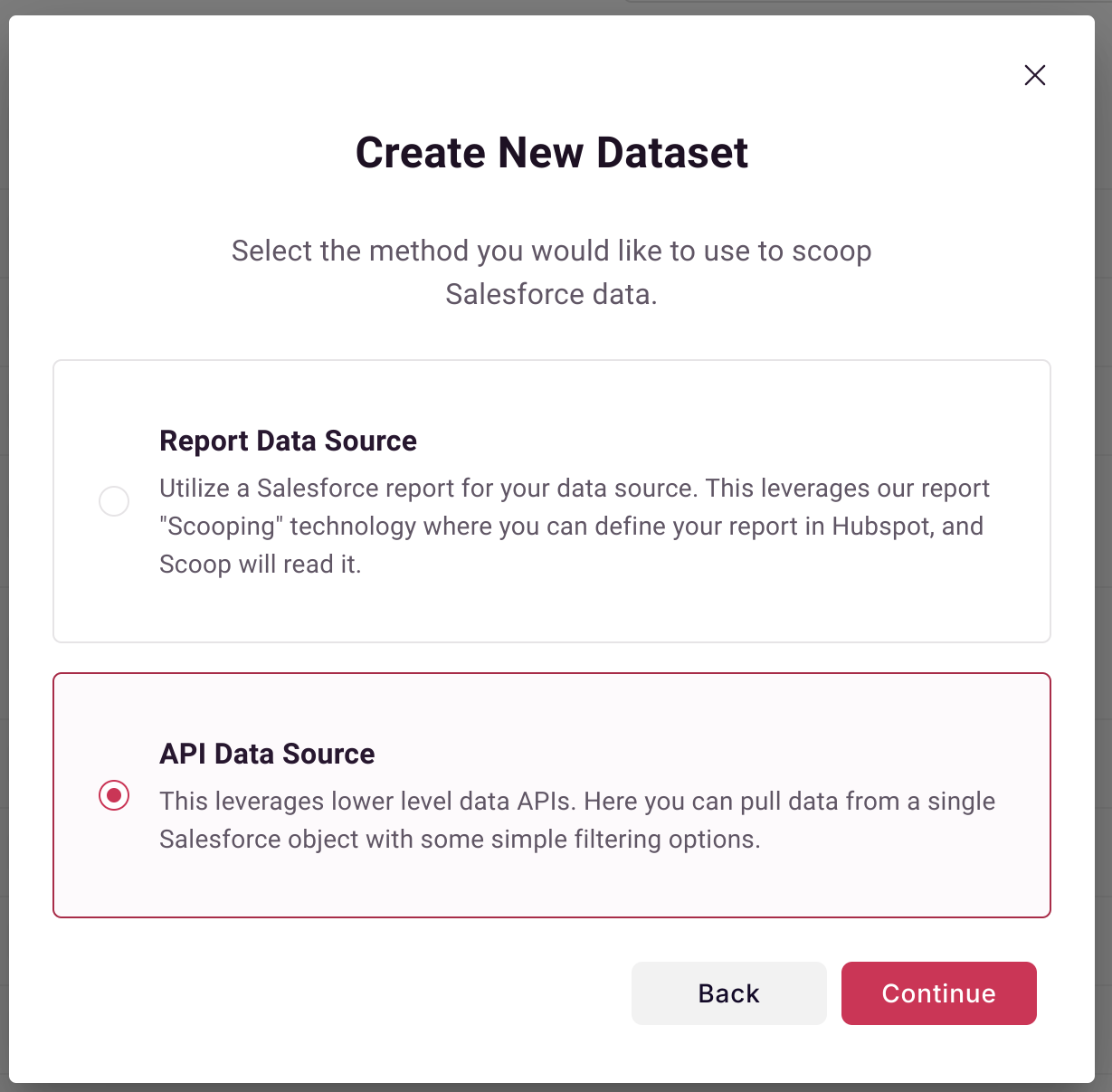
Select whether you are selecting an object that you want to snapshot daily, or an object which is transactional (e.g. an activities object).
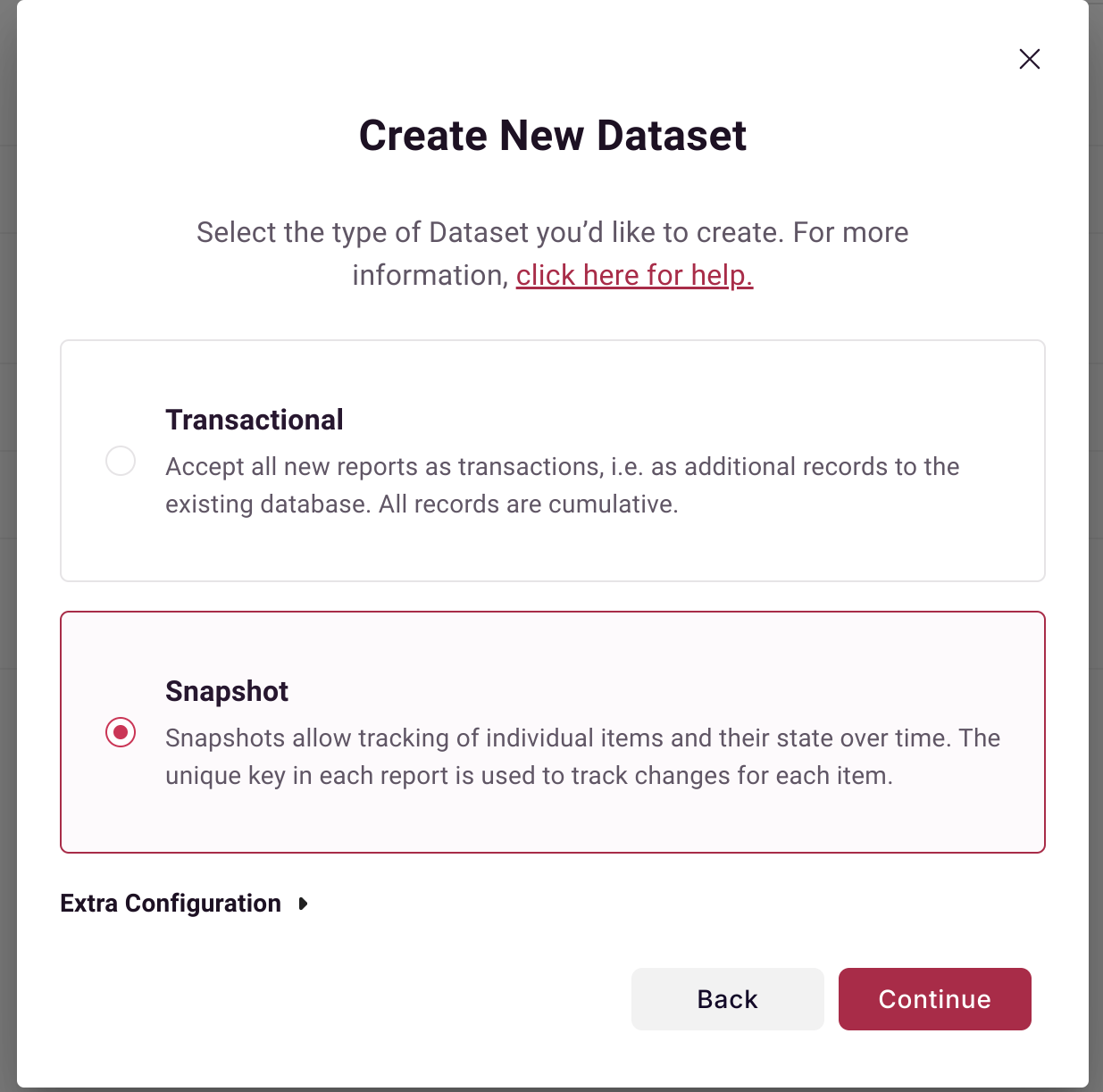
After connecting to Salesforce to Scoop, select the object that you wish to extract, and the columns that you wish to extract.
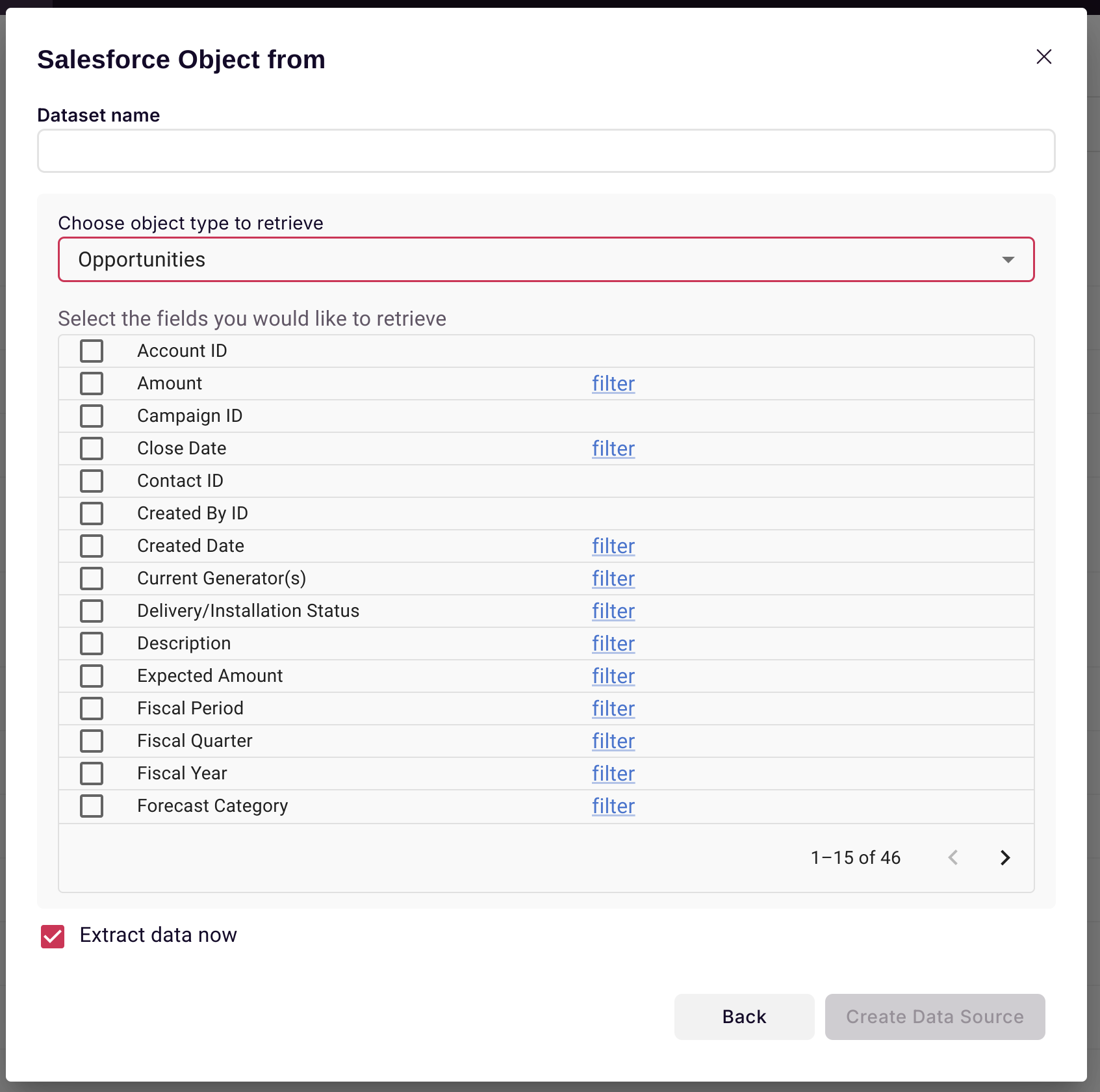
Also, select a dataset name. After you save this dialog, you can elect to have Scoop run an immediate extract (by checking the extract data now button). Scoop will automatically run this extract overnight each day after you set this up.
Writing back to Salesforce from a Scoop dataset
With Scoop you can blend data with other datasets and create new fields with ease. Scoop's ability to use spreadsheet logic gives you that same spreadsheet flexibility to add arbitrary and powerful calculations to your dataset. It is often useful to then bring those sophisticated calculations back into your source application. Scoop's API Writeback feature allows you to take any Scoop dataset and write values back into your Salesforce application. This means that you can extract data from Salesforce (which is necessary to extract the Salesforce record ID which is required to write back into Salesforce), blend it with other data or create new calculations and then push those back into your Salesforce application.
In order to write back into Salesforce, you must first establish an API connection to Salesforce and extract records that you wish to augment (see above). The Record ID will be part of your extracted dataset. You can either create calculated columns with that dataset, or you can blend that dataset with others in Scoop to create a new dataset. Be sure to make sure that the Record ID stays with your records as you blend them together (i.e. always select that column when building a new blended dataset).
Once that is done, you can now update Salesforce whenever your dataset in question is processed. When that connection is established, the following option becomes available on the dataset menu:

You can select "Setup Application Writeback" to create a writeback definition for Scoop. This definition tells Scoop what to do each time that dataset is processed. When processing is done, it will use that dataset and take the fields that you map and write them back to Salesforce using the Record IDs that you initially extracted.
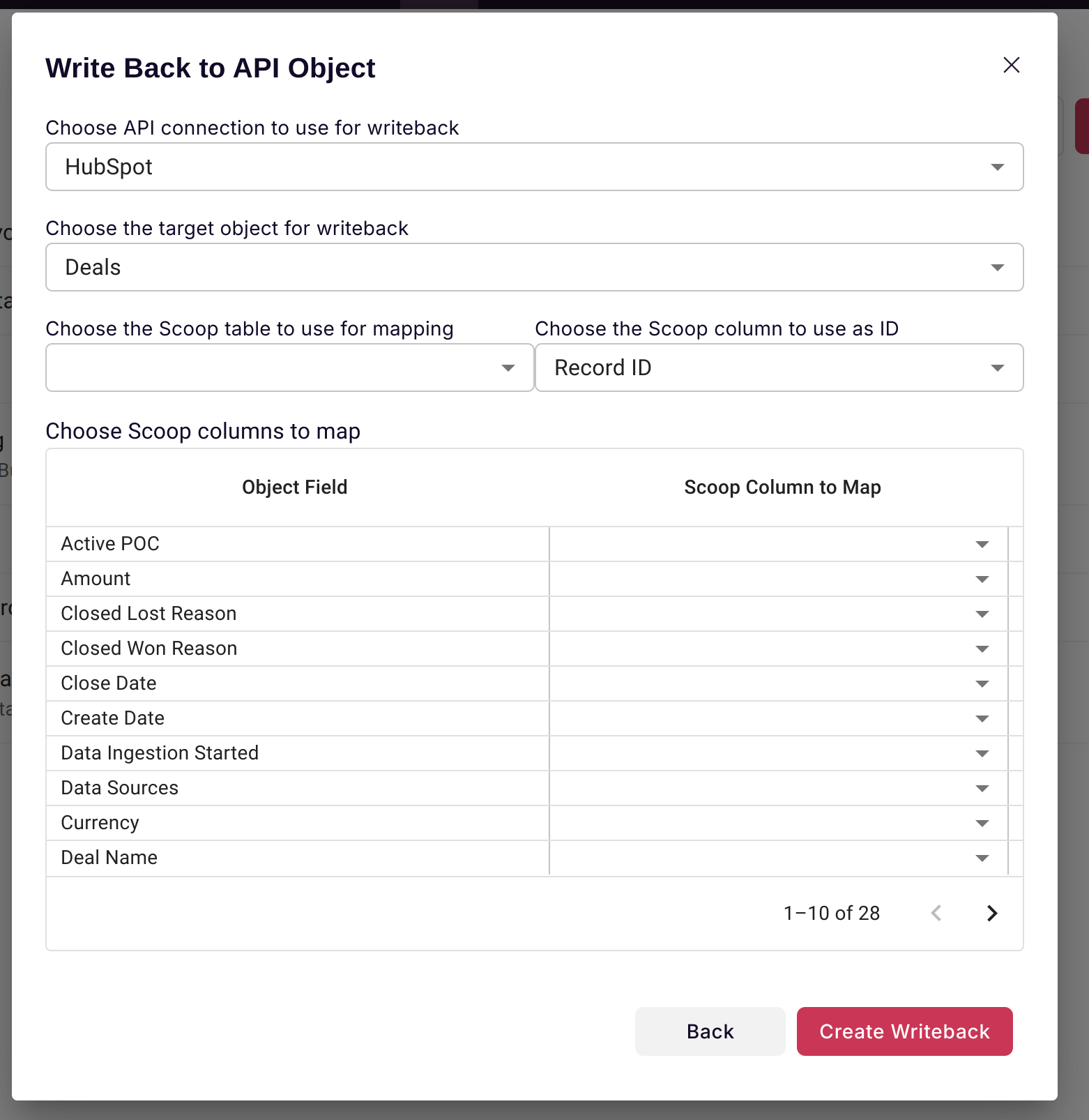
The definition essentially allows you to pick fields from one table within your dataset and map those back to fields within Salesforce.
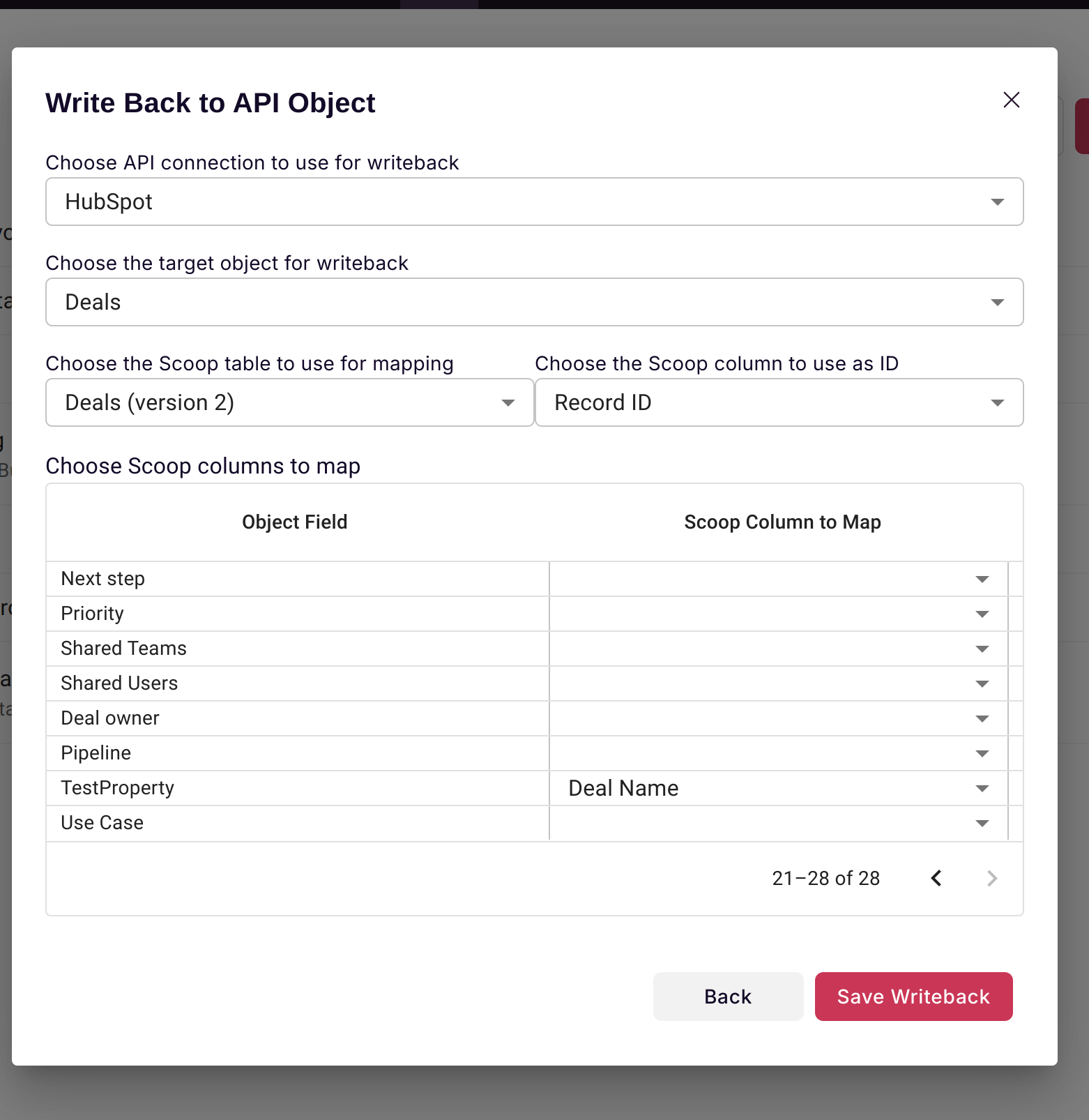
So if, for example, you wanted to map a single column in Salesforce to a Scoop dataset, you simply select from the dropdown which Scoop dataset column you want to use. Once that is done, each time that dataset is processed, Scoop will update Salesforce to ensure that that field will contain the value calculated in Scoop.
Updated 7 days ago